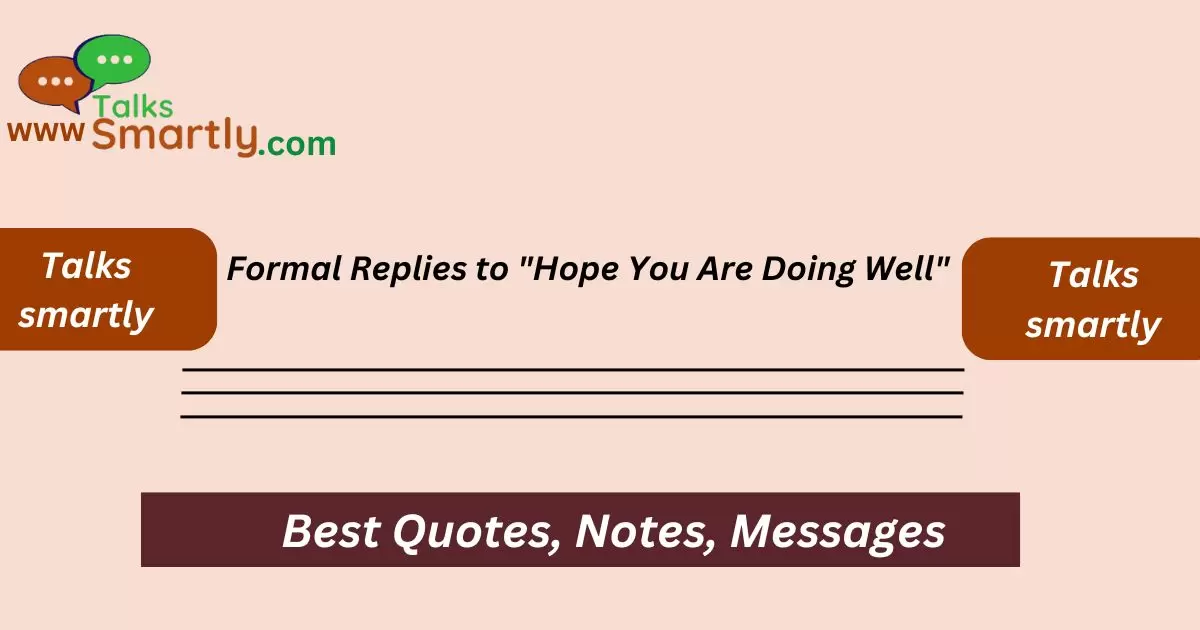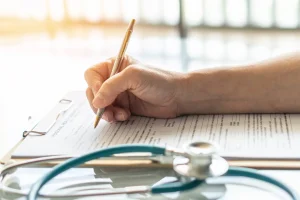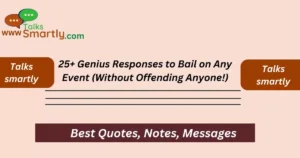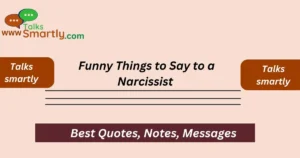In the professional world, communication is not just about exchanging information; it’s also about building relationships, maintaining respect, and showcasing professionalism. A common phrase that sets the tone for many emails and messages is “Hope you are doing well.”
This simple greeting is more than just a polite inquiry about someone’s well-being; it also acts as an icebreaker, a gesture of goodwill, and a way to establish a positive interaction from the outset.
Responding appropriately to this greeting is essential, especially in formal settings where your response can reflect your professionalism, empathy, and attentiveness. Whether you’re communicating with a colleague, a client, or a superior, the way you reply can set the tone for the rest of the conversatio
This guide offers over 30 formal replies to “Hope you are doing well,” ensuring that your responses are polished, respectful, and suitable for various professional contexts.
Standard Professional Replies
“Thank you for your kind words. I am doing well, and I hope the same for you.”
This response is a classic, professional reply that does exactly what is needed: it acknowledges the sender’s concern and reciprocates the well-wishes. It’s polite, neutral, and can be used in almost any formal context, whether in email communication or during a conversation with a colleague or client.
“I appreciate your concern. I am indeed doing well and hope you are too.”
This response not only acknowledges the sender’s concern but also subtly reinforces a mutual respect. It’s a slightly more personal touch while remaining within the bounds of professionalism, making it suitable for interactions where a bit more warmth is appropriate.
“Thank you for reaching out. I am in good health and look forward to our continued collaboration.”
This reply is particularly effective in situations where you want to reinforce your commitment to a professional relationship. By expressing a forward-looking attitude, you’re subtly signaling your eagerness to continue working together, which can be particularly useful in ongoing projects or partnerships.
“I’m doing well, thank you. I trust you are also in good spirits.”
Here, the response is not only polite but also reciprocates the positive sentiment. It’s an excellent way to maintain a positive tone in the conversation, making it a versatile choice for many professional interactions.
Motivating Morning Messages to Inspire Your Team
“Thank you for your message. I am well and hope everything is going smoothly on your end.”
This response takes a step further by expressing interest in the other person’s situation. It’s a respectful way to show that you care about the well-being of your correspondent, which can help strengthen professional bonds.
Acknowledging and Returning Good Wishes

“Thank you for your kind inquiry. I am well and wish the same for you.”
This is a simple yet effective way to show appreciation for the sender’s concern while also sending well-wishes back. It keeps the tone professional and positive, which is important in formal communication.
“I am doing well, thank you. I hope you are also enjoying good health.”
This response is warm yet formal, showing that you are not only well but that you also care about the sender’s well-being. It’s ideal for situations where you want to maintain a professional relationship while also showing a bit of personal care.
“I appreciate your message. I am in good health and wish you continued success and well-being.”
By including a wish for the other person’s success, this response adds a layer of professionalism that goes beyond just exchanging pleasantries. It’s particularly useful in contexts where you want to reinforce a positive working relationship.
“Thank you for your message. I am doing well and trust you are also in good form.”
This reply is both formal and cordial, making it suitable for professional interactions where maintaining a positive relationship is key. The phrase “in good form” adds a slightly different flavor to the conversation, making it stand out without being too informal.
“Thank you for your thoughtful message. I am well and hope your endeavors are going smoothly.”
This response not only acknowledges the sender’s concern but also shows an interest in their professional life. It’s a good choice for situations where you want to keep the conversation professional while also being supportive.
Gratitude for the Inquiry
“Thank you for your kind check-in. I am doing well and appreciate your thoughtfulness.”
This response is ideal when you want to express gratitude for the sender’s concern. It’s a polite and respectful way to acknowledge their thoughtfulness while providing a positive update on your well-being.
“I appreciate your reaching out. I am in good health and grateful for your concern.”
Expressing gratitude for someone’s concern is always a good idea in formal communication. This response not only updates the sender on your well-being but also reinforces a positive and appreciative tone in the conversation.
“Thank you for your considerate message. I am doing well and value your support.”
This response is particularly useful in contexts where the other person’s support or concern is meaningful to you. It’s a formal yet warm reply that acknowledges their kindness while also affirming your own well-being.
“Thank you for your kind words. I am well and truly appreciate your inquiry.”
Here, the emphasis is on appreciation. This response is respectful and formal, making it suitable for any professional setting where you want to express both gratitude and a positive update.
“I’m doing well, thank you for asking. Your thoughtful message is much appreciated.”
This response is brief but effective. It acknowledges the sender’s concern and expresses appreciation for their thoughtfulness, making it a versatile option for various professional contexts.
Professional and Polished Responses
“I am doing well, thank you. I look forward to our continued professional interactions.”
This response is perfect for maintaining a formal tone while also signaling your interest in ongoing professional relationships. It’s concise and to the point, yet it conveys a clear message of professionalism.
“Thank you for your inquiry. I am well and remain committed to our ongoing projects.”
Here, the response not only updates the sender on your well-being but also reinforces your commitment to professional responsibilities. It’s a strong, positive reply that keeps the conversation focused on work.
“I appreciate your message. I am in good health and am eager to advance our business objectives.”
This response is ideal for professional settings where you want to emphasize your enthusiasm for upcoming work. It’s a formal reply that also conveys a sense of readiness and dedication.
“Thank you for your thoughtful message. I am doing well and am prepared for our upcoming discussions.”
This reply is both professional and forward-looking, indicating that you are not only well but also ready to engage in future professional interactions. It’s a great way to set a positive tone for upcoming meetings or discussions.
“Thank you for checking in. I am doing well and am looking forward to our continued cooperation.”
This response is polite, formal, and emphasizes your interest in ongoing collaboration. It’s a versatile reply that works well in many professional contexts, from emails to face-to-face conversations.
Brief and Concise Replies
“I’m doing well, thank you.”
Sometimes, brevity is key in professional communication. This short, straightforward response is polite and to the point, making it a good choice for situations where a quick acknowledgment is needed.
“Thank you. I am well.”
This response is even more concise, offering a formal acknowledgment of the sender’s greeting without going into detail. It’s ideal for situations where you want to maintain professionalism but keep the conversation brief.
“I appreciate your message. I am well.”
This response adds a touch of gratitude to the brief acknowledgment, making it a bit warmer while still being concise. It’s a good balance for situations where you want to keep things short but polite.
“Thank you for asking. I am doing well.”
Here, the response is polite and to Hope You Are Doing Well” the point, offering a quick update on your well-being while also acknowledging the sender’s concern. It’s a versatile reply that can be used in many different formal contexts.
“I am well, thank you for your concern.”
This response is a bit more formal, emphasizing gratitude for the sender’s concern while also providing a brief update. It’s a good choice for more formal settings where you want to maintain a respectful tone.
Responses Indicating Positive Outlook

“Thank you for your message. I am doing well and optimistic about our future endeavors.”
This response not only confirms your well-being but also conveys a positive outlook on future work. It’s a great way to show enthusiasm for upcoming projects while maintaining a formal tone.
“I am well, thank you. I am looking forward to our future projects together.”
Here, the response is both polite and forward-looking, indicating that you are well and excited about future collaborations. It’s a positive reply that helps set the tone for continued professional engagement.
“Thank you for reaching out. I am in good spirits and excited about our upcoming tasks.”
This response emphasizes not only your well-being but also your enthusiasm for future work. It’s a great way to inject some positive energy into the conversation while remaining professional.
“I appreciate your message. I am well and am eager to continue our successful collaboration.”
This reply is formal yet enthusiastic, signaling that you are ready and eager to continue working together. It’s a good choice for situations where you want to reinforce a positive working relationship.
“Thank you for your kind words. I am doing well and am excited about what lies ahead.”
This response is optimistic and forward-looking, making it ideal for professional settings where you want to maintain a positive tone. It’s a polite, formal reply that also conveys a sense of enthusiasm.
Conclusion
In professional communication, how you respond to “Hope you are doing well” can significantly impact the tone and direction of the conversation. The responses provided in this guide are designed to help you maintain a professional, respectful, and positive tone in various formal contexts. Whether you’re engaging with colleagues, clients, or superiors, these replies ensure that your communication remains polished and effective.
By carefully choosing your words, you not only acknowledge the sender’s concern but also strengthen your professional relationships. Remember, the key to successful communication lies in being both respectful and responsive, and these replies will help you achieve just that.











